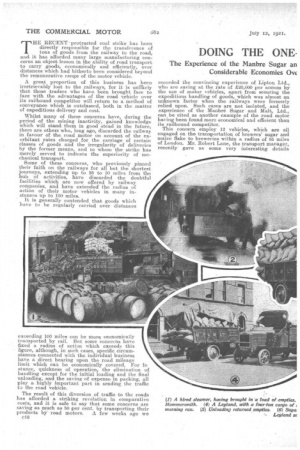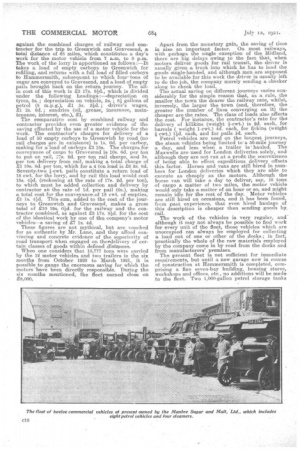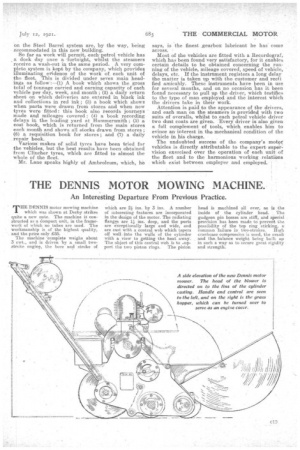DOING THE ONE 1URNEY BY ROAD.
Page 12

Page 13

Page 14

Page 15

If you've noticed an error in this article please click here to report it so we can fix it.
THE RECENT protracted coal strike has been directly responsible for the transference of tons of goods from the railway to the road, and it has afforded many large manufacturing concerns an object lesson in the ability of road transport to carry goods, economically and efficiently, over distances which had hitherto been considered beyond the remunerative range of the motor vehicle.
A great proportion of this business has been irretrievably lost to the railways, for it is unlikely that those traders who have been brought face to face with the advantages of the road vehicle over its railbound competitor will return to a method of conveyance which is outclassed, both in the matter of expeditious delivery and cost.
Whilst many of these concerns have, during the period of the mining inactivity, gained knowledge which will stand them in good stead in the future, there are others who long ago, discarded the railway in favour of -the rozi,d motor on account of the exorbitant rates charged for the carriage of certain classes of goods and the irregularity of deliveries by the farmer means, and to whom the strike has merely served to indicate the superiority of mechanical transport.
Some of these concerns, who previously pinned their faith on the railways for all but the shortest Journeys, extending up to 25 to 30 miles from the hub of activities, have discarded the doubtful facilities which are now offered by railway companies, and have extended the radius of action of their motor vehicles in many instances up to 100 miles.
It is generally contended that goods which have to be regularly carried over distances exceeding 100 miles can be more economically transported by rail. But some concerns have fixed a radius of action which exceeds this figure, although, in such ca-sea, specific circumstances connected with the individual lousiness have a direct bearing upon the road mileage limit which can be economically covered. For in stance, quickness of operation, the elimination of handling except for the initial loading and the final unloading, and the saving of expense in packing, all play a highly important part in sending the traffic to the road vehicle.
The result of this diversion of traffic to the roads has afforded a striking revelation in comparative costs, and it is safe to say that some concerns are saving as much as 50 per cent, by transporting their products by road motors. A few weeks ago we c16 recorded the convincing experience of Lipton Ltd., who are saving at the rate of 220,000 per annum by the use of motor vehicles, apart from securing the expeditious handling of goods, which was almost an unknown factor when the. railways were formerly, relied upon. Such cases are not isolated, and the experience of the Manbre Sugar and Malt, Ltd., can be cited as another example of the road motor having been found more economical and efficient than its railbound competitor. This concern employ 12 vehicles, which are all engaged on the transportation of brewers' sugar and maize flake to breweries within a radius of 85 miles of London. Mr. Robert Lane, the transport manager, recently gave us some very interesting details relating to the growth of the department. under his control, and to the operation of the fleet.
It was in October, 1919, that Mr. Lane took up his duties at Hammersmith, and at that time some 30 single and pair-horse vans hired from T. M. Fairclough and Sons, haulage contractors, were used to put about 100 tons of cargo on the rail per day, apart from effecting further town deliveries. After about eight months working under these conditions, direct deliveries by motor vehicles were suggested, and since that time the company have periodically strengthened their fleet until, at the moment, 12 motor vehicles are employed for the delivery of their products. These machines are divided between two depots, one at Stratford and the other at Hammer
smith, although the whole of the organization and control comes under the jurisdiction of the transport manager at Hanithersrnith, where all repair and maintenance work is centralized.
The fleet is composed of six 4-ton Leylands and two 25 cwt. Maxwells on the petrol side, and three 5-ton Claytons and one 5-ton Foden on the steam side, two trailea's, being kept for use with the steamers. The Leylands have seen 12 months' service, the Maxwells 15 months, two of the Clayton steamers two years, an4. the Foden and the other Clayton wagon seven years. This complement of machines has taken hundreds of tons of goads from the railway, and practically every brewery of any size which is no further than 85 miles north, south, east, or west, of Hammersmith, is now receiving its supplies af sugar and maize flake. by road. Brewers find that they got better service by this means whilst Manbre Sugar and Malt, Ltd., find that they are able to effect astonishing economies as against the railway charges—econonues which have been revealed as the result of accurate figures which are keipt showing the comparative costs for rail and road journeys.
'To give two concrete examples. Take the con
veyance of a 4-ton load to Bury St. Edmund's. First of all, let us deal with the rail charges. The railway rate for the products of the company to this place is 21 10s. 6d. per ton, to which must be added the contractor's rate for putting the lba,d on rail, i.e., .10s. 6d. per-ton, plus the rate for delivery from the railway at the journey's end of 38. 6ct. per ton, making in all 22 4s. 6d. per ton, or for a 4-ton load 28 18s.
The approximatecost of the conveyance of a similar load to the 'same destination by a 4-ton
Leyland lorry divided'under the various head ings is as follows :—Depreciation on tyres, 5s. ; depreciation on vehicle, 55. ;, 20 gallons of petrol (8 m.p.g.), 22 11s. ; driver's wages, .21 -2s. 6d. sundries (oil, grease, insurance, maintenance, interest, etc.), £1; making a total of 25 3s. 6d. The actual earning capacity of the Leyland on this journey is 28 16s.
It will be seen from these figures that the journey by road works out at 23 14s. 6d. cheaper than that by rail. The journey is done in a day ; in fact, none of the company's vehicles is away overnight, and as the return distance constitutes a long day's journey for driver and machine, matters are counterbalanced by a shorter journey the following day.
Let us take another example, and on this occasion. we will set the cost of the journey by a 4-ton lorry c17
against the combined charges of railway and contractor for the trip to Greenwich and Gravesend, a total distance of 68 miles, which constitutes a day's work for the motor vehicle from. 7 a.m. to 8 p.m. The work of the lorry is apportioned as follows: —It takes a load of empty carboys to Greenwich for refilling, and returns with a full load of filled carboys to Hammersmith, subsequent to which four. tons of sugar are conveyed to Gravesend, and a load of empty pails brought back on the return journey. The allm cost of this work is £3 17s. 80., which is divided under the following headings:a–depreciation on tyres, 5s. ; depreciation on vehicle, 5s. ;. 8.1 gallons of petrol (8 m.p.g.), 21 Ss. 2ld. ; driver's wages, 21 2s. 6d. ; sundries (oil, grease, insurance, maintenance, interest, etc.), 21.
The comparative cost by combined railway and contractor provides even greater evidence of the saving effected by the use of a motor vehicle for the work. The -contractor's charges for delivery of a load of 50 empty carboys to Greenwich by road (no rail .charges are in existence) is is. 6d. per carboy, making for aload of carboys 23 15s. The charges for conveyance of cargo to Gravesend is 10s. 6d. per ton to put on rail, 17s. 2d. per ton rail charge, and 3s. per ton delivery from rail, making a total charge of £1 10s. 8d. per ton, which for a 4 ton load is 26 2s. 8d. Seventy-two I-cwt. pails constitute a return load of 18 cwt. for the lorry, and by rail this load would cost 15s. ald. (reckoning at the rate of 17s. 2d. per ton), to which must, be added collection and delivery by contractor ati the rate of Id, per pail (6s.), making a total cost for the conveyance,of 18 cwt. of empties, 21 Is. 4W. This sum, added to the cost of the journeys to Greenwich and Gravesend, makes a gross total of RIO 19s. Old. for the railway and the contractor combined, as against 23 1.7s. 81d. for the cost of the identical work by one of the company's motor vehicles—a saving of Is. 4d. These figures are not mythical, but are vouched for as authentic by Mr. Lane, and they afford convincing and concrete evidence of the superiority of road transport when engaged on thefdelivery of certain classes of goods within defined distances. When one considers that 10,777 tons were carried by the 12 motor vehicles and two trailers in the six months from October 1920 to March 1921, it is possible to gauge the enormous saving for which the motors 'have been directly responsible. During the six months mentioned, the fleet earned close on £8,000.
Apart from the monetary gain, the saving of time is also an important factor. On most railways' with perhaps the single -exception of the Midland, there are big delays owing to the fact that, when motors deliver goods for rail transit, the driver is usually given a truck into which he has to load the goods single-handed, and although men are supposed to he available for this work the driver is usually left to do the job, the company merely sending a checker along to cheek the load.
The actual saving on different journeys varies considerably for the simple reason that, as a rule the smaller the town the dearer the railway rate, whilst, inversely, the larger the town (and, therefore, the greater the number of lines converging on it) the cheaper are the rates. The class of loads also affects the cost. For instance, the contractor's rate for the delivery of kilikins (weight i-cwt.) is 2d. each, for barrels ( weight 1-cwt.) 4(.1. each, for firkins (weight cwt.) 10. each, and for pails id. each. Petrol vehicles are used on the longest journeys, the steam vehicles being limited ton 50-mile journey a day, and less when a trailer is hauled. The Maxwells are used for London deliveries solely, and although they are not run at a profit the convenience of being able to effect expeditious delivery offsets thisfactor. Horses and vans are still hired in numbers for London deliveries which they are able to execute as cheaply as the motors. Although the horse van will take a day to deliver, say, 16 tons of cargo a matter of two miles, the motor vehicle would only take a matter of an hour or so, and might remain idle for the rest of the day. Motor vehicles are still hired on occasions, and it has been found, from past experience, that even hired haulage of this description is cheaper than sending goods by The work of the vehicles is very regular, and' although it may not always be possible to find work for every unit of the fleet, those vehicles which are unoccupied can always be employed for collecting a load out of one or other of the docks; in fact, practically the whole of the raw materials employed by the company come in by road from the docks and from manufacturers' premises. The present fleet is not sufficient for immediate requirements, but until a new garage now in course of construction at Hammersmith is completed, comprising a fine seven-bay building, housing stores, workshops and offices, etc., no additions will be made to the fleet. Two 1,000-gallon petrol storage tanks on the Steel Barrel system are, by the way, being accommodated in this new building.
So far as work will permit, each-petrol vehicle has a dock day once a fortnight, whilst the steamers receive a wash-out in the same period. A very complete system is kept by the company, which provides illuminating evidence of the work of. each unit of the fleet. This is divided under seven main headings as follow :—(1) A book which shows the gross total of tonnage carried and earning capacity of each vehicle per day, week, and month; (2) a daily return sheet on which deliveries are entered in black ink and collections in red ink ; (3) a book which shows when parts were drawn from stores and when new tyres were fitted: this book also records journeys made and mileages covered; (4) a book recording delays in the loading yard at Hammersmith ; (5) a cost book, which is returned from the main stores each month and shows all stocks dravai from stores ; (6) a requisition book for stores; and (7) a daily . repair book.
Various makes of solid tyres have been tried for the vehicles, but the best results have been obtained from Clincher tyres, which are fitted to almost the whole of the fleet..
Mr. Lane speaks highly of Ambroleum; which, he
says, is the finest _gearbox lubricant he has.' come across.
Most of the vehicles are fitted with a Recordograf, which has been found very satisfactory, for it enables certain details to be obtained concerning the running of the vehicle, mileage covered, speed of vehicle, delays, etc. If the instrument registers a long delay the matter is taken up. with the customer and recti fled amicably. These instruments have been in use for several months, and on no occasion has it been found necessary to pull up the driver, which testifies to the type of man employed and the interest which the drivers take in their work.
Attention is paid to the appearance of the drivers, and each man on the steamers is provided with two suits of overalls, whilst to each petrol vehicle driver two dust coats are given. Every driver is also given a full cemplement of tools, which enables him to evince aninterest in the mechanical condition of the vehicle in his charge.
The undoubted success of the company's inot9r, vehicles is directly attributable to the expert supervision exercised over the operation of each unit of the fleet and to the harmonious working relations which exist between employer and employed.
































